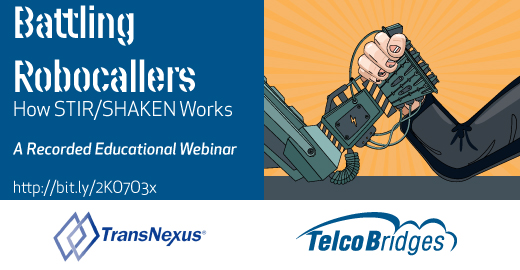 by Alan Percy, Senior Director of Product Marketing
by Alan Percy, Senior Director of Product Marketing
This last month, a telemarketing firm hawking health insurance was fined $82 million for their role in 21 million illegal unsolicited robocalls. Are the legal consequences enough to put an end to the nuisance calls?
As reported by the Washington Post, the Federal Communications Commission imposed an $82 million fine against a telemarketer who made more than 21 million unsolicited calls to consumers to try to sell health insurance and generate leads.
Despite this stiff penalty against one firm, the phones of Americans continue to ring with offers of bogus credit card protection offers, free vacations and fake IRS scams.
 A root of the problem is the ease at which bulk phone calls can be made with spoofed caller-ID information, tricking unsuspecting victims to answer call they think are from friends or neighbors. While there are legitimate reasons to substitute caller-ID information (Doctors office reminders, school notifications, etc) fraudulent abuse continues to be an industry-wide problem.
A root of the problem is the ease at which bulk phone calls can be made with spoofed caller-ID information, tricking unsuspecting victims to answer call they think are from friends or neighbors. While there are legitimate reasons to substitute caller-ID information (Doctors office reminders, school notifications, etc) fraudulent abuse continues to be an industry-wide problem.
Meanwhile, progress is being made in the standards bodies with further refinement of the STIR/SHAKEN framework that will allow service providers to “certify” that the originating caller and communications service provider owns the rights to the calling number.
In August, the ATIS and SIP Forum announced the release of two key specifications needed to standardize the user experience and APIs needed for implementation of SHAKEN. The first specification Technical Report on a Framework for Display of Verified Caller ID (ATIS-1000081) defines a standard user experience for calls from known callers, likely SPAM callers, suspect and potential fraudulent callers with color icons and information on screen-based devices. The second specification Technical Report on SHAKEN API for a Centralized Signing and Signature Validation Server provides a proposed RESTful API for the implementation of the SHAKEN specification
This next couple weeks will see two industry speaking sessions addressing the issues, including:
Battling Robocallers – a Tutorial on STIR/SHAKEN presented by yours truly at Astricon in Orlando on Tuesday, October 9th at 10:00 AM
Comprehensive Approach to Illegal Robocalls presented by Eric Burger, CTO at the Federal Communications Commission at the Illinois Institute of Technology Real-Time Communications Conference on Tuesday October 16th at 9:00 AM
Later in December, the SIPNOC event has a dedicated Robocall Summit track specifically addressing the problem, including a number of industry thought leaders.
However, questions do remain on the timeframe and motivation of the service provider community as to when they plan to implement any or all of the recommendations, giving consumers a break from the fraudulent robocallers.





 As noted by Jim Dalton, CEO of TransNexus at the start of the session, automatic dialers with pre-programmed IVR scripts (aka Robocallers) do have valid applications (reminder calls from medical offices, bill pay reminders, school closures, reverse 911…) But they are increasingly being used as part of elaborate fraud schemes, bilking victims and stealing their identities. As noted by the Treasury Inspector General for Tax Administration (TIGTA), over 10,000 victims have collectively paid over $54 million because of phone scams since October 2013. And that’s just the crime that was reported.
As noted by Jim Dalton, CEO of TransNexus at the start of the session, automatic dialers with pre-programmed IVR scripts (aka Robocallers) do have valid applications (reminder calls from medical offices, bill pay reminders, school closures, reverse 911…) But they are increasingly being used as part of elaborate fraud schemes, bilking victims and stealing their identities. As noted by the Treasury Inspector General for Tax Administration (TIGTA), over 10,000 victims have collectively paid over $54 million because of phone scams since October 2013. And that’s just the crime that was reported.